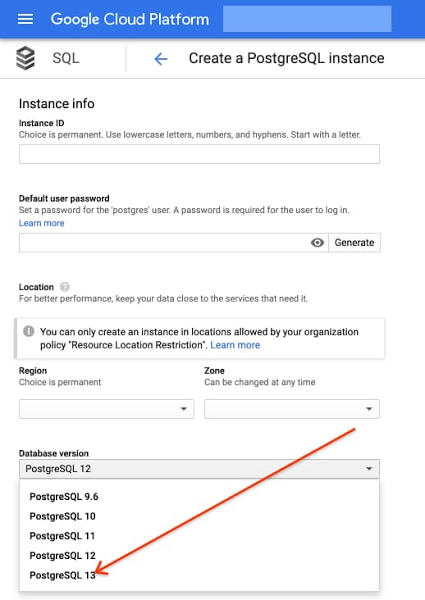Quản lý kho hàng hiệu quả là yếu tố sống còn đối với bất kỳ…
Google Cloud SQL now supports PostgreSQL 13
Today, Google announced that Cloud SQL, our fully managed database service for PostgreSQL, MySQL, and SQL Server, now supports PostgreSQL 13. With the soon-to-be-announced PostgreSQL 13, you'll have access to the latest PostgreSQL features while letting Cloud SQL handle the hard work, so your team can focus on developing applications that deliver many benefits for customers.

PostgreSQL 13 delivers performance improvements across the board, including enhanced partitioning, increased indexing and efficiency, and better scaling monitoring. Here are some new feature highlights:
- Supports additional partitioning and truncation scenarios: As part of the ongoing enhancements of partitioned tables in the two most recent versions of PostgreSQL, new cases of partition truncation and direct joins were introduced, including joins between Data tables are partitioned when their partition limits do not match exactly. Additionally, enabling BEFORE on partitioned tables is now supported.
- Sort up ascending: Organizing is a performance-intensive job, so any improvement in this area can make a difference. Now, PostgreSQL 13 introduces ascending sorting, which supports early-stage query types and sorts only unsorted fields ascending, increasing the likelihood that the sorted block will fit in memory and thus, improving performance.
- Aggregate Hash data effectively: In previous versions, during the planning phase, the Hasg data aggregation function was usable or not, depending on whether the Hash table fit in memory or not. With the new version, Hash aggregation can be determined based on cost analysis, regardless of the amount of space in memory.
- B-tree index: now works more efficiently thanks to storage reduction enabled by removing duplicate values.
- Empty: is a necessary operation for database performance, especially for important and demanding workloads. It reclaims the space occupied by dead datasets and catalogs it in a visibility map for future use. In PostgreSQL 13, advanced automation and performance improvements are being introduced:
- Empty faster: Parallel emptying of multiple indexes reduces the time taken to perform data cleanup.
- Automatically empty: Autovacuum can now be triggered by insert commands (in addition to the existing update and delete commands), ensuring the overview visibility is always updated promptly. This allows for better tuning of main memories while they remain in cache.
- Monitoring capabilities: WAL usage visibility in EXPLAIN, advanced logging options, new system views to monitor shared memory and LRU cache usage, etc.
- Additional WITH TIES enter FETCH FIRST: To ease paging, simplify processing, and reduce the number of statements, FETCH FIRST WITH TIES returns any additional rows tied to the last position in the result set by the ORDER BY clause.
Cloud SQL helps ensure you can benefit from what PostgreSQL 13 has to offer quickly and securely. With automatic patches and updates, as well as maintenance controls, you can reduce the risks associated with upgrades and the latest minor version updates.
To support high-volume enterprise workloads, this edition is also fully integrated with the latest Cloud SQL features, including IAM database authentication for enhanced security, audit logging to meet compliance and point-in-time recovery requirements for better data protection.
Database authentication with IAM
Integrate PostgreSQL with Cloud Identity and Access Management (Cloud IAM) simplifies user management and authentication by using the same Cloud IAM credentials instead of traditional database passwords.
Cloud SQL IAM database authentication unifies the authentication process, allowing administrators to track and manage user access easily and simply. This approach provides more consistency when integrating with database services GCP other, especially for environments that require multiple scales and complex environments.
Audit logging
Audit logging is now enabled in Cloud SQL for companies required to comply with certifications, government, financial or ISO requirements. Extension pgaudit allows you to create audit logs at the level of detail needed for future audit or investigation purposes. It gives you the flexibility to control logged statements by setting up configurations to specify which classes of statements should be logged.
Point-in-time recovery
Point-in-time recovery (PITR) helps administrators restore and restore an instance at a specific point in time using backups and WAL files when human error or vandalism occurs. PITR provides an additional method of data protection and allows you to restore your instance to a new version at any time in the last seven days. PITR is enabled by default when you create a new PostgreSQL 13 instance on Cloud SQL.
Get started with PostgreSQL 13
To deploy the new PostgreSQL 13 instance using Cloud SQL, simply select PostgreSQL 13 from the drop-down menu on the database instance menu:

To learn more about Cloud SQL for PostgreSQL 13, see Google documents. Cloud SQL will continue to ensure that you have access to the latest versions, while continuing to provide the best availability, security, and integration to meet your needs. Stay tuned for more updates on all Google Cloud database engines.
Source: Gimasys



